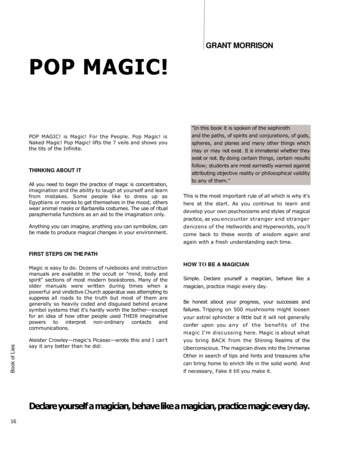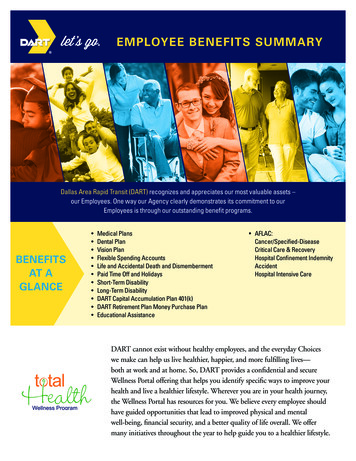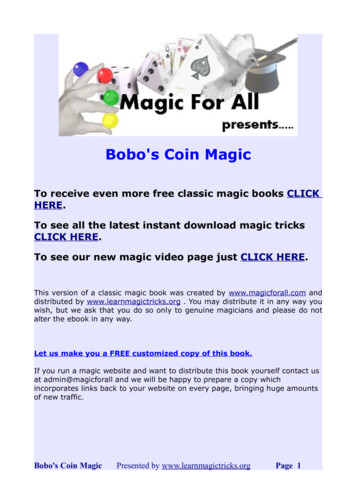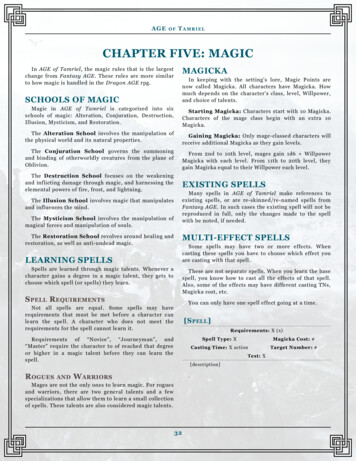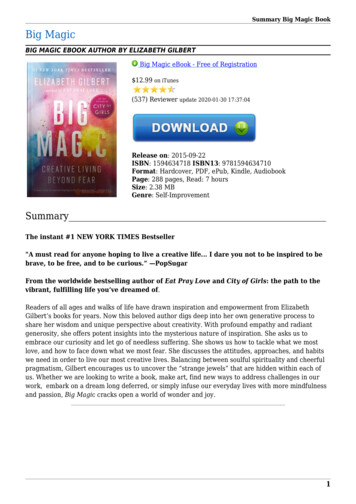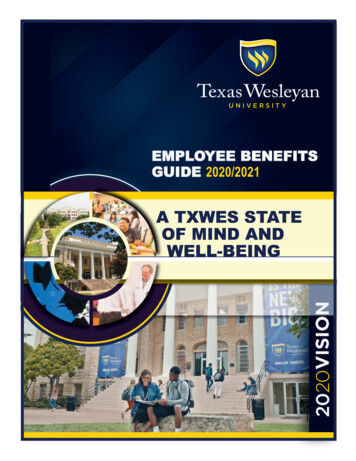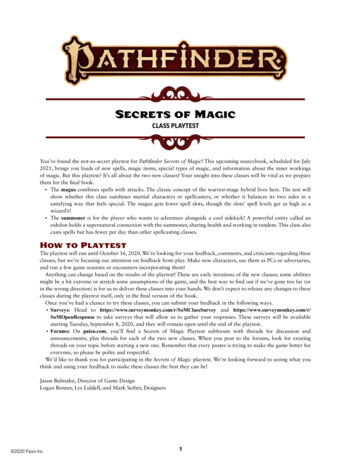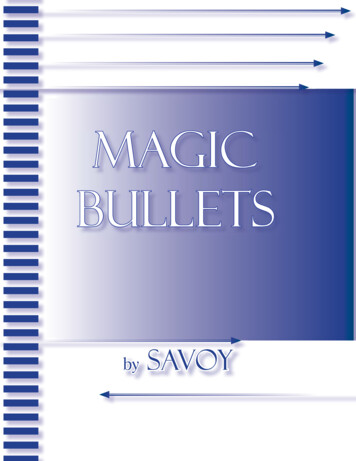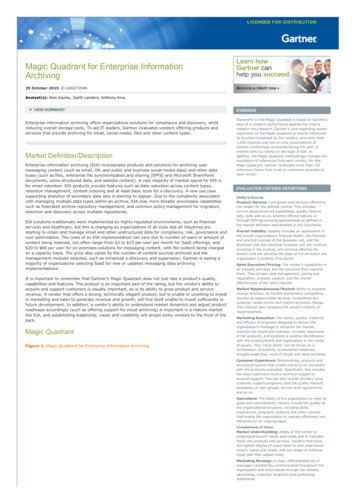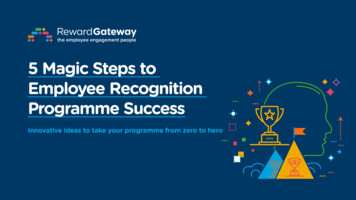
Transcription
5 Magic Steps toEmployee RecognitionProgramme SuccessInnovative ideas to take your programme from zero to hero
Table of Contents3Introduction4Set Your Employee Recognition Strategy9Decide on the Details14Build Your Employee Recognition Programme21Shine a Spotlight on Your Plan24 Measure Your ROI32Conclusion
IntroductionHi there,I’m Debra Corey, and I’ve launchedemployee recognition programmes at avariety of companies of all sizes and inmany different industries over the courseof my career. It’s becoming more andmore clear that employee recognition is nolonger a “nice-to-have,” but a “must have”in organisations who are looking to engagetheir workforce and embed their companyvalues in new and exciting ways. Butwhere to start? Choosing the right kind ofmoments of recognition is so important toshow that you’ve been listening to what youremployees want, need and enjoy receiving.3 IntroductionThis eBook will walk you through the stepsneeded to launch a top-notch employeerecognition programme, including: How to define your employeerecognition strategy. How to make key recognitiondesign decisions. How to shine a light on yourprogramme to increase engagement. Effective ways to measure thesuccess of your programmes. Names and examples of employeerecognition programmes.We’ll look at some of the things we dohere at Reward Gateway as employeeengagement thought leaders, as well asthings I’ve done throughout my career atother organisations. Now, let’s get started Debra CoreyReward Gateway Advisor
Set Your EmployeeRecognitionStrategy4 Set Your Employee Recognition Strategy
Start with “Why”Building employee recognition into youremployee engagement strategyThe best companies design jobs in a way whichNo matter what you’re creating, whetherit’s an employee benefits initiative, a newlearning platform or a top-notch recognitionprogramme, you should always startyour planning by defining your “why.”As Simon Sinek, author of “Start WithWhy,” says, “When you start with ‘why’in everything that you do, you inspireaction in a way that ‘what’ doesn’t.”The key to this is asking yourself: Why amI launching a recognition programme, andwhat do I really want to achieve with it?Whenever you’re building something, youwant to build with purpose. For instance, ifyou want to grow a garden, you wouldn’tjust plant a bunch of random flowers intothe ground, would you? You’d researchthe soil, evaluate the sunlight, and createa plan by determining what you’re tryingto achieve. Likewise, for your recognitionprogramme, your starting point shouldalways be to create a strategy based onexactly what you want to “grow.” Hereare some of the top reasons companiesput recognition programmes in place:1. Create a positive work environment.job design, learning and development, andrecognition are included right from the start.Employee recognition should be a critical partof your overall employee engagement strategy.We’ve designed a 10-step model called theEngagement Bridge to increase employeeengagement for more productive, innovativeand committed employees. Here’s a glimpseof how recognition fits into that model:2. Create a culture of recognition.3. Motivate high performance.4. Reinforce certain behaviours.So ask yourself, what am I trying to achieveand why? Discover this answer before youmove on, so you wind up with a beautifulgarden, and not just a field of weeds!Learn more about the Bridge at rg.co/bridge5 Set Your Employee Recognition Strategy
Does your organisation needemployee recognition?I believe that every company, no matterwhat size or what industry it’s in, needssome kind of recognition programme.The good news is that it doesn’t haveto be expensive. I once saw a companyuse simple Post-its as a way to recognisetheir workforce, but it does have to be apriority — 82% of employees surveyedby Gallup say praise and recognition areleading factors in helping them improvetheir job performance. If you don’t have arecognition programme, ask yourself, canmy company afford not to have 82% of myworkforce not at their peak performance?How you design your recognitionprogramme will depend on yourorganisation’s culture, values, businessgoals and the areas you’re trying to6 Set Your Employee Recognition Strategyimprove. I’ve seen companies look intobuilding recognition programmes for manyreasons, including some of these challenges: Little to no knowledge of anorganisation’s purpose, mission or values. Low morale. Negative view of company culture. Low overall engagement score. An increase in unproductive employees. Little to no collaboration amongteams or individual team members.By building a programme with purpose, you’llhave a better chance of addressing thesechallenges and introducing positive changesto both your people and your business.Did you know 50% of employees surveyed wouldleave a company if they weren’t regularlythanked and recognised for their efforts.(Source: Reward Gateway survey, 2017)Peer-to-peer recognition is 36% morelikely to have a positive impact on financialresults than manager-only recognition.(Source: SHRM)54% of employees feel their bosscould do more to appreciate them.(Source: Reward Gateway survey, 2017)Learn more at rg.co/thankyou
Create your recognition principlesGreat, you’ve answered the critical “why”question, but sorry to say that this doesn’tmean you can or should move on todesigning your recognition programme.At least, not just yet. You’ve got one morething to do first, and that is to create yourrecognition principles. These help you defineyour programme, what it stands for, whatmakes it unique and what it says to youremployees and the external marketplace.Finding the right principles will help youcreate recognition programmes which trulydrive and support your “why,” aligning withyour company’s mission, culture and values.When designing your principles, I alwayssuggest to start with your mission andvalues to ensure that your principles arestrengthening your overall company vision.7 Set Your Employee Recognition StrategyMissionValuesRecognitionPrinciples
Using Reward Gateway as an example, here’s how we’ve designed our mission, values and recognition principles to all fit and work together:Mission:Let’s make the world a better place to work.Values:Love your jobBe humanDelight yourcustomersWork hardOwn itPush theboundariesSpeak upThink globalRecognition Principles:FairnessBalanceWowEasyGive all employees theopportunity to recogniseand be recognised.Provide a range ofrecognition plansthat recognise valuesin different ways.Provide a recognitionprogramme that delightsour employees.Make recognitionplans that are easy tounderstand and use.8 Set Your Employee Recognition Strategy
Decide onthe Details9 Decide on the Details
Now it’s time to roll up your sleevesand make the key decisions about yourprogramme. These are the nitty grittydetails that answer the important questionsof “what,” “who” and “how.” It’s reallyimportant to list as many as possible tomake sure you’ve thought of everythingwell in advance. Here are some examples:What? How many different recognition plans willyou have within your overall programme(e.g. will you have one or create differentplans to drive different objectives)? What recognition award(s) will beused (e.g. gifts, experiences, cash,or something else entirely)? What will you name your programmeand individual plans, and how will thisalign with other HR programmes?10 Decide on the DetailsWho? Who will be able to send recognition? Who will be able to receive recognition? Who will administer the programme?How? What system(s) will you use to managethe programme effectively? What processes will you put in placeto ensure it runs smoothly? How and when will you measurethe success of the programme? What training will be developedand rolled out to ensure theprogramme is understood?These decisions will vary by company andby provider as all recognition programmesare built differently. Company needs varyby size, industry, workforce and otherfactors, so it’s important to take thetime and think through these questionsbefore moving on to the next step.Whichever objectives and principles youselect, double-check that they align andsupport your business goals and HRstrategy. Finally, make sure you discussthese with your key decision makers andagree on them before you begin designingyour programme, as you want to ensureeveryone has had a chance to contributeas well as set proper expectations.
Decide your “Say” and “Do”A key part of answering the question“what” is deciding what your recognitionprogramme will “Say” and what it will “Do.”These are the actual moments ofrecognition that occur at times or eventswhen you believe you should recogniseyour employees. They could be basedon activities (e.g., joining the company,having a work anniversary or a birthday) orbased on actions (e.g., helping a customer,helping a team member or suggestinga new way of doing things), or both.11 Decide on the DetailsThe “Say”The “Do”is the message you want to convey toboth the employee being recognisedand the broader organisation.is the tangible reward you wantto give to help recognise theemployee’s activity or action.Your “Say” could be.Your “Do” could be. “Congratulations!” eCards “We appreciate your hard work” Financial award “Thank you” Posting their photo on therecognition wall
Let’s put it together.Action or Activity12 Decide on the DetailsThe “Say”The “Do”A colleague is navigatinga challenging conversationand demonstrating companyvalues to overcome objections.Let them know whata great job they did inhandling conflict at work.Send them a values-basedeCard.An employee helps a customersolve a really tricky problem.Congratulate them openlyin the team huddle.The manager gives theemployee a monetary award.A team spends the entire nightworking together to organise alaunch party for the company.Let them know how much youappreciate their hard workand how much it will helpmake the launch a success.Treat the team to anight out on the town.
Continuous recognition helpsboost your “Say” and “Do”Of course, these examples are just the startof what your “Say” and “Do” approachmight include. You may be surprised tohear a “Say” is sufficient for many actionsor activities. Often we think we need to“Do” something in every situation, but inreality, employees appreciate the “Say”just as much, if not more, than the “Do.”The key here is to be sure you makeyour employees feel recognised andappreciated, creating happy memories atthe same time. The added benefit for yourorganisation is that the employee’s happymemory and experience is now foreverconnected to your company, increasing youremployee’s overall positive perspective.By making your “Say” and “Do” moments morefrequent, you can make continuous recognitiona core part of your company culture.50% of employees surveyed would leave acompany if they weren’t regularly thankedand recognised for their effortsrg.co/thankyouAt Reward Gateway, our suite of continuous recognitiontools help you boost your number of “Say” and“Do” moments. These tools include peer-to-peereCards that can be customised to match your brandand other objectives, monetary awards that havea finite pot of money attached so you can figureout how to budget appropriately, and the abilityMatch your brand and other initiatives. At RewardGateway, we have an entire set of values-driveneCards that playfully reflect all our values.13 Decide on the Detailsto nominate others at your company for whateveraward or recognition action you feel is appropriate.
Build Your EmployeeRecognitionProgramme14 Build Your Employee Recognition Programme
Each organisation has its own strategy,so building your employee recognitionprogramme will similarly depend ona variety of factors including yoursize, demographic, budget, etc. Someprogrammes will be very straightforward,with one recognition plan, while othersmay have multiple recognition plans.The RecognitionPyramid approachThe next question you’re probably askingyourself is, “how do you decide howmany plans to include in your overallprogramme?” An approach I’ve used inthe past is a recognition “pyramid,” whichis a simple model to visualise who yourrecognition programme reaches withinyour organisation. Here’s how to build one:15 Build Your Employee Recognition ProgrammeThe Recognition Pyramid approach
The bottom section of the pyramid, thewidest part, is for what I call “anyone” and“anytime” recognition, so it touches themost employees and happens the mostfrequently. Many companies use this forplans that recognise all employees, and acommon solution is peer-to-peer eCards(digital greeting cards you can send toanyone, at anytime). My colleagues atReward Gateway can customise them toembed your brand, values and messaging tomake recognition easy, and more frequent.16 Build Your Employee Recognition Programme
The middle section (you can have morethan one!) of the pyramid is where youbegin narrowing or reducing the numberof employees who are recognised. Thisis often done as a way to highlight andrecognise those employees whose actionsand accomplishments have pushed theboundaries and/or they have gone aboveand beyond with their performance.For this section, there are two commonplans — manager awards and monthly/quarterly awards. An example of the latter iswhen we used to host quarterly “Thank You”awards, in which employees would nominatetheir peers, a selection panel would choosethe winners and then we’d announce themat all-staff business meetings.17 Build Your Employee Recognition Programme
The top section, the narrowest sectionof the pyramid, is where your recognitionprogramme awards the best of the best,recognising exceptional performance. Themost common plans for this are employee ofthe year programmes or a CEO/leadershipaward.There is no right or wrong number of plans,however, I suggest concentrating on allthree kinds of tiers. If you focus only onthe top tier, you may be missing out onthe opportunity to recognise more of yourstaff and, ultimately, improve engagement.One other tip is to make sure each sectionof the pyramid is clearly defined as well ashow it differs from the others, or you riskconfusion, misuse and even disengagement.To learn more about the pyramid and how tobuild your own, visit rg.co/pyramid for otherexamples.18 Build Your Employee Recognition Programme
What’s in a name?One of the most important decisions youcan make is the name of your programme.The name will determine your overall brandand theme of the recognition programme,and, of course, this is the name youremployees will use over and over again asthey engage with the programme. Hereare a few tips I’ve picked up to make sureyour name will lead you to success:1. Create meaningby asking yourself if the name relates backto the programme and if it’s somethingyour employees will engage with. Forinstance, one of the most popular namesI’ve seen is “Star” because it immediatelybrings up the image of someone standingin the limelight for their achievements.19 Build Your Employee Recognition Programme2. Make your name stand out4. Think beyond the “now”with an interesting (but easy to remember)word or phrase that will cut throughthe clutter of their inbox or otherannouncements, and will look fabulouson your engagement platform.by selecting a name that can stand thetest of time and be more evergreen.3. Keep the name simple5. Consider involvingemployees to help youname the programmeby making sure it can be easily pronouncedand understood. Also keep in mind thatnot all words mean the same thing inall places, so this is especially importantif you have a global workforce.by creating some extra buzz leadingup to the launch and give employeesa sense of ownership from the startby inviting individuals or teams tohelp come up with the name.
Adding MORE to yourrecognition programmeI’ve seen dozens of names over the years, but here are some that I findcan be easily relatable in organisations of all shapes and sizes:In the latest revamp of Reward Gateway’s ownRecognition Programme Namesrecognition programme, we chose the nameMake sure your employee recognition programme name has impact. Examples include:Above &BeyondAccoladeAllStarsApplauseStand outMORE! — Moments of Recognition Everyday.StarThe acronym MORE! sums up what we’re tryingto do, give more recognition. The individualInspireKudosShineSimplyThanksCheersThe ExtraMilewords represent our aim to create recognitionmoments, which we believe are a key partof recognition, and to do it continually.The new recognition programme includes:Peer-to-peer eCards:Peer-to-peer awards:High FiveYou RockManager awards:Game Changer20 Build Your Employee Recognition Programme
Shine a Spotlighton Your Plan21 Shine a Spotlight on Your Plan
Now that you’ve developed your worldclass recognition programme, it’s time toput the spotlight on recognition. Publiciseyour programme with special spotlightsthat tell employees how great it is andhow to use it, and add extra spotlightson those who are being recognised (ifappropriate for your organisation). After all,they’ve done something worth recognising,so get out there and shout about it!Here are a few particularly specialspotlights to get you thinking Launch withimpactAs the expression goes, “You only getone chance to make a first impression!”That’s definitely true when it comes tolaunching your recognition programme22 Shine a Spotlight on Your Plan— this will be your biggest opportunityto show employees how engaging andexciting your programme will be.To create some buzz, you could launchit with a fun video, create a teaser orcountdown campaign, go on a recognitionroadshow or do desk drops of brandedmaterial so it’s always on view. The biggerthe impact your recognition programmehas from the start, the more it will beremembered and used throughoutyour company on an ongoing basis.Keep italiveYour recognition programme, like all yourpeople initiatives, should never be a “setit and forget it” play. You need to keepyour programme fresh, and a great wayto do this is to shine a constant spotlighton it in new and different ways.Here are a couple ways to do that: Create a video montage of recognitionmoments. Post an interview with a recognitionrecipient. Run a value-of-the-month campaign toget employees talking and recognisingeach other based on the value. Create a competition to see whocan send or receive the mostrecognition during a period of time.You can even use a recognition leaderboardto encourage a little friendly competitionamong employees. Whatever you do,find ways to keep it fresh and alive atyour company.
GetsocialEverything we do these days is social,so why not consider adding a socialaspect to your recognition programme?At Reward Gateway, we use what wecall the “Wow Wall,” which is part ofour employee recognition platform.The way it works is that every timea colleague receives an eCard, it’sautomatically showcased to the rest ofthe company (if they choose to), andemployees can like or comment onthe recognition gesture, similar to theinteractions on other social media platforms.Employees love it, and it helps us achievethe objectives of our programme.23 Shine a Spotlight on Your PlanIncorporating features you see on socialmedia puts the spotlight on the personbeing recognised, giving your entireworkforce the opportunity to celebratetogether and it subtly encourages youremployees to recognise each other, asthey’re constantly reminded that youhave a recognition programme.As your recognition programmeevolves, your spotlights will as well. Themost important thing to remember isnot to let it fade away, as you wantrecognition to remain a critical part ofengaging your employees. That won’thappen if no one knows about it!Go mobile with the Connect appIntroduce your people to an on-thego employee recognition app with asocial recognition wall and companyblogs right at their fingertips. Send,comment and react to eCards right fromthe app. Plus managers can deliver onthe-spot recognition, even during theirdaily commute!
Measure Your ROI24 Measure Your ROI
As part of your process, I’m sure you’llspend time talking to your leadershipteam and part of that discussion willinevitably be measuring the ROI (returnon investment) on your programme. Tosuccessfully do this, you need to pull fromyour original strategy and show that yourprogramme has accomplished the goalsyou’ve set out to achieve, and how. If you’reworking with a prospective provider, thatprovider may be able to give you examplesof how their product worked for others ordata points that will help prove your ROI.Many companies paint this pictureby reporting on changes in retention,profit, customer satisfaction and/or employee engagement, showinghow they’ve increased as an indirectresult of their recognition programme.These are common business ROIs,and ones that business leaders will25 Measure Your ROIeasily relate to and understand.You may wish to measure other ROIsdirectly related to your recognitionprogramme, such as the following:ProgrammeusageThis measures interaction with theprogramme and individual plans. It couldinclude the number of eCards sent, thenumber of award nominations made, theamount of clicks on recognition stories, etc.SocialactivityThis also measures interaction with theprogramme and plans, but is specificto social interaction. It could includethe number of likes or commentsemployees are receiving or giving.AnecdotesNever underestimate the power of a greatstory. Report specific stories and examplesthat highlight the value your programme andplans are having with your workforce. Thesedemonstrate the value of investment (VOI),as you won’t have a hard measurement.The key here is to select the right picturebased on the right measurements, sothat your business leaders will see theconnection between your programme andchanges in these measurements. Makesure to test these with your leaders beforemeasuring, so that you get it right from thestart and don’t spend time and resourcespreparing reports that serve no purpose.
The business impact of strategic recognitionBringing recognition into your employeeengagement efforts is a must — we’vefinally understood that, I hope! Thoughtfulrecognition is a powerful way to showappreciation, help employees learn fromeach other and help your team focuson “the wins.” When you get good atrecognising those who do their jobwell or go above and beyond their role,employees benefit in many ways.Strategic recognition helps create theenvironment for more engagement becausepeople are getting what they crave.RespectPurposeRelationships26 Build Your Employee Recognition ProgrammeHere’s how recognition ties into giving employees more Respect, Purpose and Relationshipsat work:“I was really working hard on that project and put in some extra timeFeel more respectedoutside of work. I’m really proud that my efforts were evident to othersand that they see the impact of what I do.”Can more clearlysee the purpose andimportance of theirwork“I was surprised to get recognised for how I handled that customerBuild betterrelationships withothers“It was so nice of Steve to notice the extra effort I gave in thatinteraction. I didn’t realise the customer was so connected in thecommunity. It means a lot to see how my actions might have a realimpact on how someone talks about our company!”meeting. I don’t work with him a lot, but I will keep an eye out for moreopportunities to help his team.”
The ripple effect of strategic recognitionYet, the impact of recognition is muchbigger than on just the individual.Recognising people for the work they do ispart of building a strong, healthy workplace.And employee recognition is powerful. Ithas the potential to inspire people to adoptnew ways of doing things, it helps fostera culture of appreciation and gratitudeand it can also help your organisationreach its desired goals and objectives.Strategic recognition is when youshow appreciation for a successthat helped improve the employeeor customer experience and thatcan be tied to your company’svalues, purpose or objectives.27 Build Your Employee Recognition ProgrammeJust because we’re being strategic doesn’tmean we have to be boring. Rather, thinkabout how adding a little bit more beyondthe “thank you” can turn a nice messageinto one that has a meaningful impact onyour team and your company as a whole.Don’t worry writing the perfect strategicrecognition message is easy! It only involvesthree steps. And once you get into thehabit of doing it, you won’t think twicethe next time you go to acknowledgesomeone for doing a good job.1. Tell the actionIt sounds simple because it is. What specificactions did the person do? Tell the storyin a couple of sentences. It doesn’t needto be a novel, just enough informationso people who may not work with thatindividual every day know what happened.Telling the action ensures that others onyour team will be more informed of greatwork and the types of actions they can do todeliver on your company’s mission, purposeand values. Being specific also makes surethat the recognition is genuine, focusedon merit and doesn’t feel like favoritism.Helpful tip: Think abouttelling the story in a waythat a new employeecan clearly understandwhat they would do ina similar situation.
2. Connect to an area offocus or company valueEmployee recognition is a greatopportunity to tie employee actions toyour company’s values, goals, mission orpurpose. This helps people on your teammake the connection between what theydo every day with the big picture of yourorganisation’s priorities and objectives.It’s key to “walk the talk,” especially as aleader. Connecting the recognition messageto the values, purpose, etc., demonstratesthat those important pieces of yourbusiness are top of mind for you too! Asyou lead by example, people on your teamwill adopt the practice and soon enough,that link between the values and day-today actions will become easier to see.28 Build Your Employee Recognition Programme3. Explain the impactThis step is about the result of the action.Why was it important and how did itaffect your team, your customers or thecompany as a whole? Again, get specific– if you only report on what happened,you miss out on the appreciationpiece that influences engagementand creates an inspiring moment.While the benefit of the action mayseem obvious to you, it may not be toothers, especially if they are not on thesame team or in the same department.Helpful tip: You may evenwant to consider whatwould have been theimpact if the person didnot do what they did.To truly see the strategic impact ofemployee recognition, it’s key to embedit in your company culture. Let’s use asimple analogy. Think about skipping astone across a pond each time the rocktouches the water a series of tiny wavesripple away from the impact point.When you recognise someone for doingtheir job well, the same thing happens. Theinitial impact (on the person you recognise)spreads as the others in your organisationread about the recognition. That ripplespreads even more when your team startsto build the actions into their day-to-daywork, which can have a real impact on yourteam’s (or company’s) goals and objectives.As more people get on board withmaking recognition a habit – a partof your work culture (the “way we dothings around here”) – the ripple effectspreads throughout the organisation.
Creating a culture of continuous recognition leads to:The more employees feel the benefits above, the more likely they are to give their best efforts to supportIncreased engagementand productivity:the company, creating an environment for improving employee engagement. This leads to improvements incountless areas, for example, faster problemsolving, fewer mistakes, more innovation, less stress and improvedwell-being to name a few.Reductions in unwantedturnover:Increased focus on themost important goals:When top performers feel that their work is appreciated, they are less likely to look elsewhere for a job. Asrecognition becomes an integral part of your employee engagement efforts, you’ll see more and more peoplewho are willing to stay even if offered a similar job elsewhere.When the whole team (and leaders) are talking about and acknowledging actions that made an impact bywriting a strategic recognition message, employees are reminded about the goals that the company is focusedon. These reminders do a lot to drive the results that are most important to the company.The right kind of employee reward and recognition programme can make a big impact. Think about how you can incorporate strategicrecogniton to boost and round out your company’s employee engagement efforts.29 Build Your Employee Recognition Programme
A look at the Reward Gateway rewardand recognition programmeOur own suite of recognition and rewardfeatures (yes, we like to put the recognitionbefore the reward!) helps you showcaseachievements across your team andemployees with meaningful moments ofrecognition, while embedding recognitionwithin your company culture with on-thespot tools accessible anytime, anywhere.What’s more, our recognition tools helpconnect your people to your purpose,mission and values by highlighting thebehaviours that drive your businessforward. Here’s a look into what we offer:Peer-to-peeremployee recognitionOur peer-to-peer employee recognitionprogramme offers tailored eCards tofit every organisation’s unique goalsand brand. Anyone can send or receivemoments of recognition to showcasemoments of values-driven behaviour,celebrate a big (or small!) win or welcomenew team members on board.SocialrecognitionEmployee recognition is most effective whenothers can share in that special moment, and30 Build Your Employee Recognition Programmethat’s easy to do with social recognition. PluseCards and other rewards are displayed ona
programme, you should always start your planning by defining your "why." As Simon Sinek, author of "Start With Why," says, "When you start with 'why' in everything that you do, you inspire action in a way that 'what' doesn't." The key to this is asking yourself: Why am I launching a recognition programme, and
